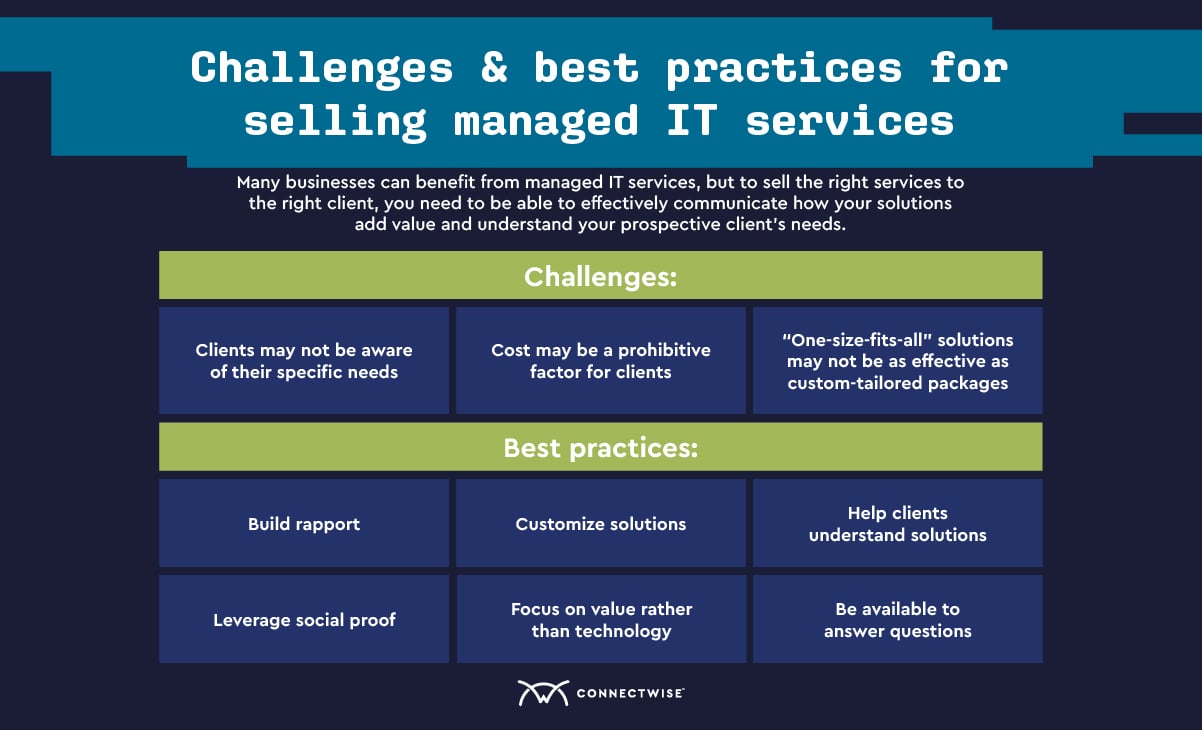Companies looking to grow often need a managed service provider (MSP) to maintain their IT infrastructure and services. Helping prospective clients appreciate and understand the value of engaging with an MSP is one of the essential parts of the managed IT services sales cycle.
This begs the question: How do you sell managed services?
In several industries and verticals, the most common managed services include:
- Cybersecurity
- Software-as-a-Service (SaaS) management
- Disaster planning and recovery
- Cloud application infrastructure and maintenance
- Remote monitoring
- Equipment management
Several businesses can benefit from managed IT services. Still, to sell the right services to the right client, you must effectively communicate how your solutions add value and understand your prospective client’s needs.
Managed IT services: How do they fill clients’ needs?
Managed IT services provide a full array of support services that allow clients to focus on growing their businesses. Providing users with an easy-to-access portal and IT support are two ways MSPs support their partners. Managed IT services also offer technical support that keeps businesses out of a break-fix cycle.
Businesses sometimes find themselves in disaster recovery situations, whether it is client support through a help desk ticket or planned maintenance on critical systems and networks. The ability to quickly address critical systems failures or significant data loss is one reason many companies can survive after a disaster. Managed IT services give business owners peace of mind that their systems and networks are protected.
Managed IT services assist businesses by:
- Monitoring and maintenance of IT systems and servers
- Remotely monitoring and deploying critical software updates
- Performing network monitoring and intrusion detection
- Providing employee technology support
Managed IT services sales cycle
Knowing how to sell managed IT services to clients includes understanding how each phase of the sales cycle works. Stages of the managed IT services sales cycle include:
- Discovery. Uncovering the correct information to align your solutions with your client’s needs and objectives.
- Presentation and Proposal. Presenting the solutions you can provide, proposing pricing, and laying out the steps to implementing your strategy.
- Negotiation. Negotiating sticking points or parts of the engagement that clients wish to change or adapt to suit their needs or specific financial situation.
- Close. Signing the contract and scheduling the first steps in implementing the strategy.
Download our e-book, “Selling Managed Services: 6 Tips to Reinvent Your Sales Pitch,” for a better understanding of the pros and cons of adding managed services to your repertoire.
Questions to ask your clients
Selling managed services requires understanding your client’s problems, expectations, and goals. Knowing this information will give insight into which solutions your business can use to best support the client. To get this information, it is essential to ask pertinent questions that can uncover gaps in how the business manages its IT services and tech infrastructure.
Have you ever outsourced any of your business operations or IT services before?
Knowing whether your potential clients have ever outsourced business operations or engaged with another MSP will give you a greater understanding of their familiarity with the outsourcing process. It will also help you understand the level of client education you’ll need to begin the sales process with.
Tell me about your experiences — both good and bad — with MSPs.
When brainstorming how to sell managed services to prospective clients, it's critical that you know their past experiences with other MSPs and how you can exceed their expectations. Exceeding expectations is key, as it will provide an instant way to differentiate yourself based on customer experience. You’ll also be able to better understand what worked in their past relationships to adapt to their needs and preferences.
What are the most critical apps and technology your business uses to serve your customers?
To shape the package of solutions you’ll present, it’s necessary to determine which apps and technology your business will be expected to support, and whether these make sense for your potential client.
Who is the vendor responsible for the majority of your business’ IT software or solutions?
Experience with disaster recovery planning and overseeing software data backups can be one of the most important reasons a business chooses one MSP over another. It’s a good idea to ask your potential client which vendor is responsible for most of their business’ IT software. Understanding and matching your solutions with your prospect’s data storage and maintenance expectations is also a good idea. Ask to see any disaster recovery plans they may have created.
What is the process for your business to address gaps in your IT infrastructure or general outages?
It’s critical for a business to limit service outages for their clients as much as possible, and in the event that an outage does occur, the business should have plans to alert its users. This information can give you an idea of the business’ IT maintenance cycle and how you can best exceed your potential client’s expectations, given the solutions you’re able to provide. There also may be an opportunity for you to provide an immediate suggestion to help your client, which builds trust and opens the door to suggest other services.
Challenges when selling managed IT services
Several challenges exist for MSPs engaged in selling managed IT services. To match the services you offer with your client’s needs, you’ll need to guide your customer in understanding which solutions will benefit them the most and why you’re the right provider to help them reach their goals.
Here are a few of the most common challenges when selling managed services:
- Clients may not be aware of the specific needs they have or services an MSP manages.
- Cost may be a prohibitive factor for many potential clients.
- “One-size-fits-all” solutions may not be as effective as custom-tailored packages for some clients.
Managed services: Best practices for selling
Now that we’ve discussed how to sell managed services, it’s essential for you to know a few of the best practices when preparing to sell your solutions to prospective clients:
- Build a rapport. Building a rapport helps to improve communication between you and your potential client. Find common ground and use open-ended questions to learn information that may be useful to determine how you can create a best-fit scenario.
- Customize your solutions. Customizing your packages and solutions enables you to serve specific client needs.
- Help your clients understand your solutions. Provide your clients with information that makes their choice more accessible. If they’re comparing two MSP solutions, provide a comparison chart or send links to relatable content that helps them understand the benefits of your offerings.
- Leverage social proof. By using practices and tools to utilize reviews and testimonials from your clients, you can establish credibility early on with prospects.
- Focus on value rather than technology. Clients are often more focused on what benefits and savings a potential solution can provide their organization instead of just the technology that drives the solution. Provide your potential client with a list of benefits and reasons why they should choose your product over your competitor’s.
- Be available to answer questions. It’s always a good idea to be available during the sales process to answer any questions or address doubts your prospective client may have about your solution. Remember, be proactive and reach out to ask if you can clarify any concerns or issues.

Pricing managed services
Pricing is top of mind during the latter part of the sales process. Selling managed IT services isn’t just about providing benefits to your users; it’s also necessary to provide these benefits and solutions at a price that aligns with your target market’s budget.
There are a few popular pricing models you can use to price managed services:
- Monitoring-only model. Monitors for potential software updates and incidents and forwards this information to the client for further action.
- Per-device model. Charges clients for each monitored device, and services are performed on each device as needed.
- Per-user managed services model. Bills clients a flat fee, per month, for all used devices on the network.
- Tiered services pricing model. These are typically the most popular with MSPs. This pricing model bundles popular services into packages addressing issues or gaps clients may face.
- Total-solution/complete package pricing model. Total solution pricing models include all remote support and on-site support. This pricing model is highly flexible but costly due to its “all-you-can-eat” nature. Budget-conscious clients may be inclined to choose a package or per-device pricing model.
- A la carte pricing model. In a contrast to the other options on this list, the MSP allows individual services to be purchased as needed. So for example, if a client only wanted patch management and data recovery, they could specifically only get those services.
Getting Started Selling Managed IT Services
Ready to level up your sales processes to better connect with MSPs? Contact us today to learn more about ConnectWise’s portfolio of business management tools & software for MSPs.















